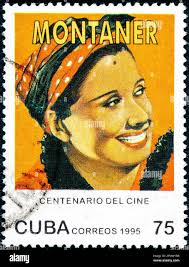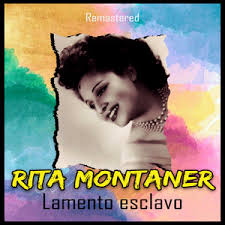RITA MONTANER, ONE OF THE MOST CHARISMATIC CHARACTERS IN CUBAN POPULAR CULTURE. PHOTOS. VIDEOS
Rita Montaner, who was called “the only” by the people was one of the myths of the Cuban stage. She assumed and explored all of the genres and ways of performance, from the theater to the cabaret.
Rita Aurelia Montaner Facenda born in Guanabacoa, La Havana in 1900, was one of the most charismatic characters in Cuban popular culture. That woman with cinnamon skin, and a marvelous mole on her forehead, had a careful musical education and received high-level instruction, after she graduated, with a golden medal at the Peyrellade Conservatoire, one of the most famous institutions in the country.
Nonetheless, and despite her personal charms, the excellency of her piano interpretation which could have consecrated her as a concert performer of cultured music, the theater, as well as the radio and afterward the cinema and television were to be the privileged spaces for this passionate woman who had an ironic character and an explosive life.
VIDEOS- Rita Montaner sings “El Manisero” (Trailer)..
She died on April 17, 1958, in her birth city, since this woman from Havana and known all over the world, like many of the great personalities from Cuban music, had been born in Guanabacoa, a village which belongs today to the capital city, almost a month before becoming 58 years old and the victim of cancer which silenced her voice.
But she is not remembered in Cuba painfully or from her death. Rita is music and music is life, as she demonstrated at only 22 years old when it was her voice the first to be heard singing, in the program which was inaugurated in 1922 the Radio in Cuba, in the PWX broadcasting station.
Five years later, already eighty years ago, Rita Montaner got hold forever of the stage and of lyric theater, when she made her debut in the traditional Spanish operetta Niña Rita, a piece which was premiered in 1927, by the master Ernesto Lecuona, to assume with her voice and her acting abilities, one of the anthological moments of the Cuban musical pentagram, the congo-tango Mamá Inés.
Next year, and in 1928 with her debut in Paris, in stages such as the Olimpia and the Palace of the French capital, she became known to other public, and her name began to be expanded, as when in 1931, she also performed in the United States, to offer concerts and recitals, shown where she was always the main star, and where she was frequently surrounded by the talent of Bola de Nieve in the Piano.
Rita Montaner assumed and explored every genre and way of performance on stage, from the theater to the cabaret, maintaining one of her best places in the mythic Tropicana, where she started an already legendary season in 1949 together with Bola de Nieve himself. She was also an actress for the radio and television, where she made her charisma and her critical irony evident during the 1940s and the 1950s.
RITA MONTANER CINEMA CAREER…
Cinema, in Cuba as well as in Mexico, had her among her main stars. She gave life to melodramas and gave a special touch of humor and sensibility to the so-called musical genres, with the wit of her grace and that singular intensity of her interpretations, as was to be demonstrated in El Romance del Palmar (The Romance of the Palm Grove), a movie made in 1938 which since it was premiered that December, was the Cuban talking movie of the pre-revolutionary era with the highest box office earnings in and outside of Cuba.
About a decade later she would give it a try in Mexican movies, with films such as María la O, from 1947, an argument inspired in the famous traditional Spanish operetta from Ernesto Lecuona. In 1952 she would be again the main star in another Cuban movie, La Única (The Only), the title which became the epithet of the actress-singer in her career, and with which she was unanimously recognized by the people.
Her versatility, the mastery of her talent, led her to adventures that could have been qualified as suicide for other people. In this way, and already ill, with her cancer wound in her throat, she gave life to an opera in 1950s Havana, La médium, by the Italian Gian Carlo Menotti, to immortalize the character of madame Flora which years later was assumed by the mezzo-soprano, Alba Marina.
For that reason, surrounded by the love of her people, while she was still lucid she enjoyed the tribute which, through the television media, was offered to her by the most famous singers and musicians, a few days before her death, in 1958. For those endless reasons, we feel in debt to that wonderful woman, that willing and demanding artist eighty years after her debut on the Cuban stage.
RITA MONTANER, UNA DE LAS ARTISTAS MÁS CARISMÁTICAS DE LA CULTURA POPULAR CUBANA. PHOTOS. VÍDEOS
Rita Montaner, a quien el pueblo llamaba “la única”, fue uno de los mitos de la escena cubana. Asumió y exploró todos los géneros y formas de actuación, desde el teatro hasta el cabaret.
Rita Aurelia Montaner Facenda nacida en Guanabacoa, La Habana, fue uno de los personajes más carismáticos de la cultura popular cubana. Aquella mujer de piel canela, y un lunar maravilloso en la frente, tuvo una esmerada educación musical y recibió una instrucción de alto nivel, luego de graduarse, con medalla de oro, en el Conservatorio Peyrellade, una de las instituciones más afamadas del país.
No obstante, y a pesar de sus encantos personales, la excelencia de su interpretación pianística que pudo haberla consagrado como concertista de música culta, el teatro, así como la radio y luego el cine y la televisión serían los espacios privilegiados de esta apasionada mujer que tuvo un carácter irónico y una vida explosiva.
Murió el 17 de abril de 1958 en su ciudad natal, pues esta habanera y conocida en todo el mundo, como muchas de las grandes personalidades de la música cubana, había nacido en Guanabacoa, villa que hoy pertenece a la capital. , casi un mes antes de cumplir 58 años y víctima de un cáncer que acalló su voz.
VIDEOS- Rita canta “Ay Jose!” (Cortos)..
Pero no se la recuerda en Cuba con dolor ni desde su muerte. Rita es música y la música es vida, como lo demostró con tan solo 22 años cuando fue su voz la primera que se escuchó cantar, en el programa que inauguró en 1922 la Radio en Cuba, en la emisora PWX.
Cinco años después, hace ya ochenta años, Rita Montaner se afianzó para siempre a los escenarios y al teatro lírico, cuando debutó en la tradicional opereta española Niña Rita, pieza que fue estrenada en 1927, por el maestro Ernesto Lecuona, para asume con su voz y sus dotes actorales, uno de los momentos antológicos del pentagrama musical cubano, el congo-tango Mamá Inés.
Al año siguiente, y en 1928 con su debut en París, en escenarios como el Olimpia y el Palace de la capital francesa, se da a conocer a otro público, y su nombre comienza a ampliarse, como cuando en 1931 actúa también en Estados Unidos, para ofrecer conciertos y recitales, muestra donde siempre fue la estrella principal, y donde frecuentemente estuvo rodeada por el talento de Bola de Nieve en el piano.
Rita Montaner asumió y exploró todos los géneros y formas de actuación sobre el escenario, desde el teatro hasta el cabaret, manteniendo uno de sus mejores lugares en la mítica Tropicana, donde inició una temporada ya legendaria en 1949 junto al propio Bola de Nieve. También fue actriz de radio y televisión, donde hizo patente su carisma y su ironía crítica durante las décadas de 1940 y 1950.
RITA MONTANER CARRERA EN EL CINE…
El cine, tanto en Cuba como en México, la tuvo entre sus principales estrellas. Dio vida a los melodramas y dio un toque especial de humor y sensibilidad a los llamados géneros musicales, con el ingenio de su gracia y esa singular intensidad de sus interpretaciones, como quedó demostrado en El Romance del Palmar. el palmeral), película realizada en 1938 que desde su estreno en diciembre fue el cine sonoro cubano de la época prerrevolucionaria con mayor recaudación de taquilla dentro y fuera de Cuba.
Aproximadamente una década más tarde lo intentaría en el cine mexicano, con películas como María la O, de 1947, un argumento inspirado en la famosa zarzuela tradicional española de Ernesto Lecuona. En 1952 sería nuevamente la protagonista principal de otra película cubana, La Única, título que se convirtió en el epíteto de la carrera de la actriz y cantante, y con el que fue unánimemente reconocida por el pueblo.
Su versatilidad, el dominio de su talento, la llevaron a aventuras que podrían haber sido calificadas de suicidio para otras personas. Así, y ya enferma, con su herida de cáncer en la garganta, dio vida a una ópera en La Habana de los años 50, La médium, del italiano Gian Carlo Menotti, para inmortalizar el personaje de madame Flora que años más tarde asumió el mezzosoprano, Alba Marina.
Por eso, rodeada del cariño de su pueblo, mientras aún estaba lúcida disfrutó del homenaje que, a través de los medios televisivos, le ofrecieron los más célebres cantantes y músicos, pocos días antes de su muerte, en 1958. Por esas infinitas razones, nos sentimos en deuda con esa mujer maravillosa, esa artista dispuesta y exigente a ochenta años de su debut en los escenarios cubanos.
Agencies/ Wiki/ AfroCubaWeb/ Mercedes Santos/ Karen López/ Extractos/ Excerpts/ Internet Photos/ YouTube/ Arnoldo Varona/ www.TheCubanHistory.com
THE CUBAN HISTORY, HOLLYWOOD.



 RITA MONTANER, one of the Most Charismatic Characters in Cuban Popular Culture. PHOTOS. VIDEOS. * RITA MONTANER, una de las Artistas más Carismaticas en la Cultura Popular Cubana. PHOTOS. VIDEOS.
RITA MONTANER, one of the Most Charismatic Characters in Cuban Popular Culture. PHOTOS. VIDEOS. * RITA MONTANER, una de las Artistas más Carismaticas en la Cultura Popular Cubana. PHOTOS. VIDEOS.





